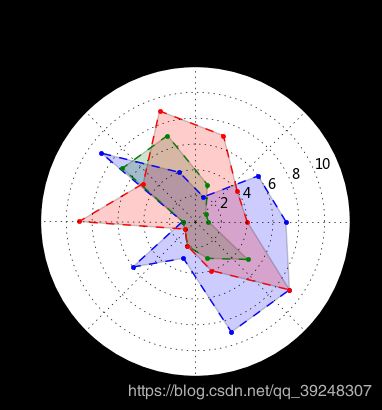1.创建极坐标轴
s = pd.Series(np.arange(20))
theta=np.arange(0,2*np.pi,0.02)
print(s.head())
print(theta[:10])
# 创建数据
fig = plt.figure(figsize=(8,4))
ax1 = plt.subplot(121, projection = 'polar')
ax2 = plt.subplot(122)
# 创建极坐标子图
# 还可以写:ax = fig.add_subplot(111,polar=True)
ax1.plot(theta,theta*3,linestyle = '--',lw=1)
ax1.plot(s, linestyle = '--', marker = '.',lw=2)
ax2.plot(theta,theta*3,linestyle = '--',lw=1)
ax2.plot(s)
plt.grid()
# 创建极坐标图,参数1为角度(弧度制),参数2为value
# lw → 线宽
---------------------------------------------------------------------
0 0
1 1
2 2
3 3
4 4
dtype: int32
[ 0. 0.02 0.04 0.06 0.08 0.1 0.12 0.14 0.16 0.18]

2.极坐标参数设置
theta=np.arange(0,2*np.pi,0.02)
plt.figure(figsize=(8,4))
ax1= plt.subplot(121, projection='polar')
ax2= plt.subplot(122, projection='polar')
ax1.plot(theta,theta/6,'--',lw=2)
ax2.plot(theta,theta/6,'--',lw=2)
# 创建极坐标子图ax
ax2.set_theta_direction(-1)
# set_theta_direction():坐标轴正方向,默认逆时针
ax2.set_thetagrids(np.arange(0.0, 360.0, 90),['a','b','c','d'])
ax2.set_rgrids(np.arange(0.2,2,0.4))
# set_thetagrids():设置极坐标角度网格线显示及标签 → 网格和标签数量一致
# set_rgrids():设置极径网格线显示,其中参数必须是正数
ax2.set_theta_offset(np.pi/2)
# set_theta_offset():设置角度偏移,逆时针,弧度制
ax2.set_rlim(0.2,1.2)
ax2.set_rmax(2)
ax2.set_rticks(np.arange(0.1, 1.5, 0.2))
# set_rlim():设置显示的极径范围
# set_rmax():设置显示的极径最大值
# set_rticks():设置极径网格线的显示范围

3.雷达图1 - 极坐标的折线图/填图 - plt.plot()
plt.figure(figsize=(8,4))
ax1= plt.subplot(111, projection='polar')
ax1.set_title('radar map\n') # 创建标题
ax1.set_rlim(0,12)
data1 = np.random.randint(1,10,10)
data2 = np.random.randint(1,10,10)
data3 = np.random.randint(1,10,10)
theta=np.arange(0,2*np.pi,2*np.pi/10)
# 创建数据
ax1.plot(theta,data1,'.--',label='data1')
ax1.fill(theta,data1,alpha=0.2)
ax1.plot(theta,data2,'.--',label='data2')
ax1.fill(theta,data2,alpha=0.2)
ax1.plot(theta,data3,'.--',label='data3')
ax1.fill(theta,data3,alpha=0.2)
# 绘制雷达线

4.雷达图2 - 极坐标的折线图/填图 - plt.polar()
# 首尾闭合
labels = np.array(['a','b','c','d','e','f']) # 标签
dataLenth = 6 # 数据长度
data1 = np.random.randint(0,10,6)
data2 = np.random.randint(0,10,6) # 数据
angles = np.linspace(0, 2*np.pi, dataLenth, endpoint=False) # 分割圆周长
data1 = np.concatenate((data1, [data1[0]])) # 闭合
data2 = np.concatenate((data2, [data2[0]])) # 闭合
angles = np.concatenate((angles, [angles[0]])) # 闭合
plt.polar(angles, data1, 'o-', linewidth=1) #做极坐标系
plt.fill(angles, data1, alpha=0.25)# 填充
plt.polar(angles, data2, 'o-', linewidth=1) #做极坐标系
plt.fill(angles, data2, alpha=0.25)# 填充
plt.thetagrids(angles * 180/np.pi, labels) # 设置网格、标签
plt.ylim(0,10) # polar的极值设置为ylim

5.极轴图 - 极坐标的柱状图
plt.figure(figsize=(8,4))
ax1= plt.subplot(111, projection='polar')
ax1.set_title('radar map\n') # 创建标题
ax1.set_rlim(0,12)
data = np.random.randint(1,10,10)
theta=np.arange(0,2*np.pi,2*np.pi/10)
# 创建数据
bar = ax1.bar(theta,data,alpha=0.5)
for r,bar in zip(data, bar):
bar.set_facecolor(plt.cm.jet(r/10.)) # 设置颜色
plt.thetagrids(np.arange(0.0, 360.0, 90), []) # 设置网格、标签(这里是空标签,则不显示内容)





